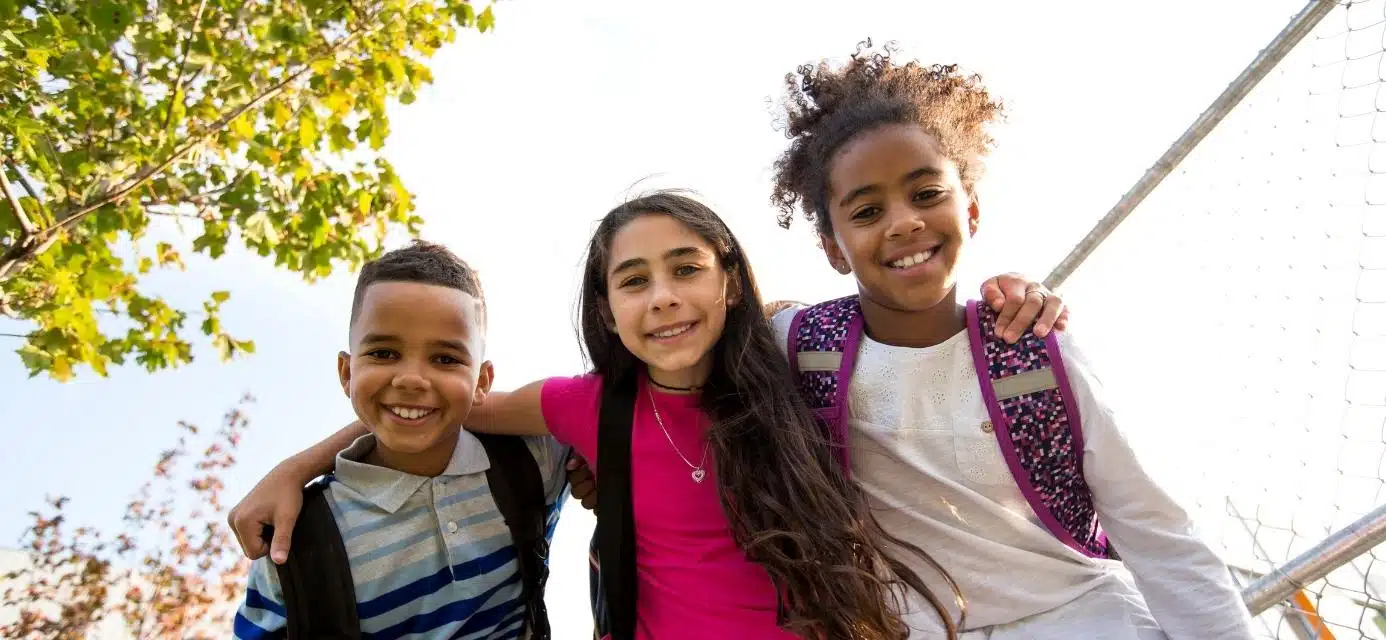Middle childhood is a time of enormous social and physical growth. “Tweens” are no longer little kids, but they’re not yet teenagers with more responsibilities. Their bodies are changing, their brains are developing rapidly, and they’re becoming more socially aware. All of these shifts can make middle childhood a difficult time for many kids—and for their parents.
What age is middle childhood? This stage of behavioral, physical, emotional, and social development unfolds between the ages of 9 and 11. And why is it important to be familiar with developmental milestones for 9-year-olds, 10-year-olds, and 11-year-olds? Because pre-teen and teenage developmental milestones provide clues about a child’s mental and physical health. If your child doesn’t meet their developmental milestones, they can experience a developmental delay. That may mean they need specific services to help them catch up to other children their age.
Which Phase of Development Is From 9–11 Years?
Children ages 9–11 are in what’s considered the middle childhood stage of development. The psychologist Erik Erikson came up with eight stages of development, during which each age group must master a “task.” The middle childhood stage, according to Erikson, is known as “industry vs. inferiority.”
This essentially means that children during this stage of development either become proud of their accomplishments or feel inferior to their peers. If they experience the latter, these feelings can lead to low self-esteem during this stage of development and onward.
Children ages 9–11 become more independent during this stage of their development. Making friends and learning appropriate social cues is essential for this age group.As your child grows, you’ll notice a difference in their interests, their friendships, and their attitude towards others.
Middle Childhood and Puberty
Physical development is a key part of middle childhood. Children in this developmental stage are becoming stronger. They may experience a growth spurt. Their balance and coordination are increasing, allowing them to do more physical activities. Their bodies are starting to mature.
Kids ages 9–12 are getting ready to enter puberty. Some children enter puberty early in this stage of their lives. Girls may get their periods at this age, and develop breasts and body hair. Boys may start experiencing a change in their voices and facial hair growth. Parents may start to notice their kids’ body odor during middle childhood.
Reaching pre-teenage developmental milestones includes joy and excitement but also all the growing pains of middle childhood. Children in this age group may struggle with these new changes in their bodies and feelings. In addition, teasing and bullying can start around this stage of development.
What Social Developments Occur During Middle Childhood?
Social development in middle childhood is crucial in order for a child to meet their developmental milestones. It’s important during this time that you encourage your child to explore friendships as they prepare for middle school and eventually high school. School-age children make friends by doing things together, such as joining a sports team or a club at school.
This will set them up for the “industry” part of Erikson’s middle childhood developmental task, meaning that they become more active and industrious in their activities. The more exposure they have to other children their age who have similar interests, the better set up they’ll be for meeting their upcoming teenage developmental milestones. Cultivating lasting friendships during this time will set them up to have a strong support system as they get older.

3 Types of Social Development in Middle Childhood
Children during this stage of development may experience peer pressure. If your child struggles with confidence, body image, or low self-esteem, it can be difficult to stand up to peer pressure. Children who have a strong sense of self are more likely to withstand peer pressure and its negative emotional effects.
Kids this age develop loyalty towards other children and friend groups. This can be both a good and a bad thing, as children can be cruel, resulting in mean girl behaviors, for example. We already talked about peer pressure, but it’s worth mentioning again because kids in middle childhood are very impressionable. Watch for signs of bullying as you help your child navigate friendships and peers during this time in their life.
Children this age may be drawn to peers of the same gender. With younger children, it’s more common for children of different genders to play together. But as children get closer to becoming teenagers, they may want to hang out with other children of the same gender.
A Special Note: It can be difficult for kids who identify as transgender to figure out where they belong at this age. Does a male trans child assigned female at birth (AFAB) hang out with the boys or the girls? If your child is trans, keep an eye out for bullying, depression, anxiety, suicidal ideation, and other mental health considerations. Seek help if you notice anything troublesome.
Cognitive Developmental Milestones for Children in This Age Group
Along with social and physical changes, children ages 9–11 experience cognitive growth as the brain develops. By the end of this stage, kids are usually able to:
- Do more complicated problem-solving
- Handle a higher level of academic challenges in school
- Become more independent of parents and family
- Consider others’ point of view
- Think abstractly as well as concretely
- Pay attention for longer periods of time
- Engage in cooperative group activities focused on cognitive tasks, like puzzles and games
Cognitive Development for ages 9–11 Within Pre-Teen Friendships
As part of cognitive development at 9–11 years old, children begin to reconceptualize friendships. There are three stages of a child’s conceptualization of friendships during middle childhood.
- Mutuality: Children ages 9–11 start basing relationships with their peers on mutual likes and dislikes. This can be difficult if children start to bully or peer-pressure others. But the good news is that children during this developmental stage are actively looking for friends who share their interests.
- Normative expectation: This means that children ages 9–11 are realizing that real friends are nice to them. They’re learning to share in a different way than younger children do. Kids in this developmental stage are more concerned with kindness than those in developmental stages just before and after middle childhood.
- Empathy and understanding: A key part of social development in middle childhood is making friends who are loyal and caring, and who want to share things about themselves that are more private than they would have when they were younger. Children start sharing secrets with each other and learning to trust their friends and to return their trust.
Behavioral Developmental Milestones in Middle Childhood
Every child is unique, and despite the standard pre-teen and teenage development milestones, they will grow and evolve at their own rate. Hence, 9-year-old boy behavior development may be different than another’s. And what you should expect from your 11-year-old daughter isn’t the same for every parent.
That said, there are common behavior development milestones for middle childhood. This is particularly true in how they relate to parents. They may become less affectionate and seem more interested in spending time with peers rather than family. During this period, kids start to be more influenced by peers, although parents still loom large as authority figures.
Teen behaviors may also reflect this age group’s growing emotional sensitivity. They may be more prone to sadness and stress, or become angry and aggressive more frequently. While some pre-teens grow in confidence and assertiveness at this age, others get more insecure and shy in social situations.

Signs of Mental Health Issues for Ages 9–11
Children in middle childhood may begin to struggle with mental health issues such as anxiety, depression, suicidal ideation, eating disorders, and behavioral issues. Unfortunately, it can be hard to tell the difference between teenage developmental milestones and mental health challenges during prepubescence.
To make matters even more challenging, your child may not understand what they’re experiencing with their mental health. All they know is that something feels “off.” They may be having a hard time making friends or focusing on school. They might act out at home or get angry for what may seem like no reason.
Children of this age don’t usually understand what’s happening to them and hence avoid talking about it. They may be embarrassed and don’t want anyone to know that they’re struggling. So they withdraw or try to hide what they’re feeling. That’s why it’s so important for parents to become familiar with the signs and symptoms of mental health challenges.
Red-Flag Behaviors to Watch for in Middle Childhood
- Spending all their time alone in their room
- Self-confidence is diminishing rather than increasing
- Behavior at school is aggressive or antisocial
- Poor or failing grades
- Change in appetite, weight, or eating patterns
- Nightmares or trouble sleeping
- Temper tantrums at home
- Mood swings
- Problems concentrating
- New fears and avoidance behaviors
- No longer interested in activities they used to enjoy

When Your 9- to 11-Year-Old Needs Additional Support
Being the parent of a tween is difficult for many reasons. A big one is that many parents don’t know how to help their child with mental health challenges. It might be tempting to try to figure it out on your own, but it’s always better to err on the side of asking for help. Mental health professionals can help you and your child figure out what’s going on and access mental health services.
If you need help finding age-appropriate resources in your area, contact us. Newport Academy is here to help you and your child manage social development in middle childhood and the mental health challenges that may accompany this crucial period of growth.

Key Takeaways
- Middle childhood is the stage of physical and emotional development between the ages of 9 and 11.
- Puberty may begin during this stage. Girls may get their periods and develop breasts and body hair. Boys may start experiencing a change in their voices and facial hair growth.
- Social development in middle childhood includes stronger interest and connection to peers. Bullying and peer pressure also become more common.
- Cognitive abilities grow during this stage, including the development of more complicated and less concrete thinking and more skill in solving problems and working cooperatively.
- Behavioral changes during middle childhood can include mood swings, aggression and anger, and beginning to favor peer interaction over parents.
- It can be easy to confuse pre-teen development with warning signs of anxiety or depression. That’s why it’s so important for parents to be aware of the signs and symptom of mental health challenges in ages 9–11.
Frequently Asked Questions About Pre-Teenage Developmental Milestones
This period of growth is known as middle childhood. While growth is slower during this time than in teen years, middle childhood is still a time of emotional, physical, cognitive, and behavioral changes.
At this stage, children are more interested in peer connections and more influenced by peers. They develop stronger friendships and become loyal to a particular friends of friend groups. In addition, peer pressure and bullying behaviors increase during this stage.
At this age, children begin to think more abstractly, handle more complicated problem-solving tasks, and express themselves more effectively. Physical changes at age 11 may be slow or may indicate the beginning of puberty, such as getting their period, developing breasts, growing body hair, and experiencing growth spurts.






